Moisturizing Skincare Products Market Size and Share Forecast Outlook 2025 to 2035
The Moisturizing Skincare Products Market is expected to record a valuation of USD 32,004.7 million in 2025 and USD 64,508.3 million in 2035, with an increase of USD 32,503.6 million, which equals a growth of 202.8% over the decade. The overall expansion represents a CAGR of 7.3% and a 2X increase in market size.
During the first five-year period from 2025 to 2030, the market increases from USD 32,004.7 million to USD 45,437.5 million, adding USD 13,432.8 million, which accounts for 41.3% of the total decade growth. This phase records steady adoption in daily face moisturizers and hydrating serums, driven by expanding consumer awareness of barrier repair and hydration layering. Daily face moisturizers dominate this period as they cater to over 41.2% of total applications requiring high emollient retention.
The second half from 2030 to 2035 contributes USD 19,070.8 million, equal to 58.7% of total growth, as the market jumps from USD 45,437.5 million to USD 64,508.3 million. This acceleration is powered by widespread adoption of multi-molecular hyaluronic formulations, ceramide-infused creams, and AI-personalized moisturizer recommendations in retail and e-commerce channels. Hydrating serums and sleeping masks together capture a larger share above 58.8% by the end of the decade. Digital skin diagnostic tools and cloud-linked skincare analysis platforms add recurring service revenue, increasing the software-driven personalization share beyond 20% in total market value.
Quick Stats for Moisturizing Skincare Products Market
Moisturizing Skincare Products Market Value (2025): USD 32,004.7 million
Moisturizing Skincare Products Market Forecast Value (2035): USD 64,508.3 million
Moisturizing Skincare Products Market Forecast CAGR: 7.3%
Leading Segment in Moisturizing Skincare Products Market in 2025: Hydrating Serums (58.8%)
Key Growth Regions in the Moisturizing Skincare Products Market: North America, Asia-Pacific, Europe
Top Key Players in Moisturizing Skincare Products Market: CeraVe, Neutrogena, Nivea, La Roche-Posay, Eucerin, Cetaphil, Kiehl’s, Olay, The Ordinary, Clinique
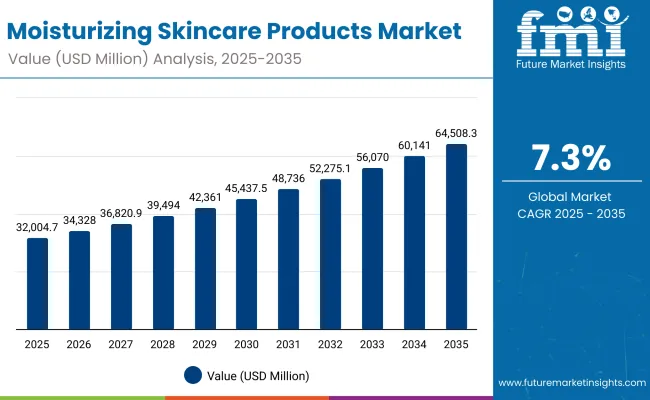
Moisturizing Skincare Products Market Key Takeaways
Metric
Value
Moisturizing Skincare Products Market Estimated Value in (2025E)
USD 32,004.7 million
Moisturizing Skincare Products Market Forecast Value in (2035F)
USD 64,508.3 million
Forecast CAGR (2025 to 2035)
7.3%
From 2020 to 2024, the Moisturizing Skincare Products Market grew steadily as dermatologist-endorsed hydration brands expanded their global distribution footprint. During this period, the competitive landscape was dominated by established clinical brands controlling nearly 70-75% of revenue, with leaders such as CeraVe, Neutrogena, and Eucerin focusing on barrier-repair and hyaluronic acid-based formulations. Competitive differentiation relied on clinical validation, dermatological trust, and affordable mass-premium pricing, while digital engagement remained secondary. Service-driven personalization models had limited presence, contributing less than 10% of total market value.
Demand for Moisturizing Skincare Products will expand to USD 32,004.7 million in 2025, and the revenue mix will shift as digital personalization and AI-driven skin diagnostics grow to over 20% share. Traditional leaders face competition from emerging digital-first brands leveraging data-based recommendations and subscription refill models. Major brands are pivoting toward hybrid ecosystems integrating e-commerce, tele-dermatology, and smart skin analytics to retain relevance. New entrants offering cloud-linked skin tracking and AR-based consultation platforms are gaining share, as competitive advantage shifts from ingredient innovation alone to digital connectivity, scalability, and recurring engagement streams.
Why the Moisturizing Skincare Products Market is growing?
The growing awareness of skin barrier health and hydration balance is fueling demand for moisturizing skincare products. Consumers increasingly prefer multi-functional formulations featuring humectants like hyaluronic acid, glycerin, and ceramides that restore and retain moisture. Expanding dermatological endorsements, combined with visible efficacy claims and adaptive textures for diverse climates, are amplifying product adoption. This demand shift is supported by the expansion of clinical skincare brands and enhanced product availability through online and offline retail channels.
The market’s growth is accelerated by digital transformation and personalized skincare ecosystems. Online platforms, influencer-led content, and AI-based skin analysis tools are enabling precise product recommendations and stronger consumer engagement. Subscription-based models and digital refill programs are expanding repeat purchase behavior across emerging markets. Additionally, the surge in virtual dermatology consultations and social commerce trends has strengthened product visibility and consumer trust, positioning digital-first brands and established players for long-term market expansion.
Segmental Analysis
The Moisturizing Skincare Products Market is segmented by product type, key ingredients, skin type, distribution channel, end user, and region. By product type, the market includes daily face moisturizers, hydrating serums, rich creams & balms, and sleeping masks, representing the core hydration formats across mass and premium categories.
By key ingredients, segmentation covers glycerin & polyols, hyaluronic acid (multi-MW), ceramides & fatty acids, and squalane/esters, which define product efficacy and texture. By skin type, the market is divided into dry, normal, combination, and sensitive skin formulations tailored to moisture retention and barrier repair.
Distribution channels include pharmacies/drugstores, e-commerce, supermarkets & hypermarkets, and specialty beauty retail, reflecting both clinical and retail-driven consumer access. End users encompass women, men, unisex family care, and senior skin, capturing demographic and lifestyle-specific hydration needs.
Regionally, the market spans North America, Europe, East Asia, South Asia & Pacific, Latin America, and the Middle East & Africa, with China, India, Japan, and the USA emerging as key growth centers through 2035.
Insights into the Product Type Segment with Hydrating Serums Leading in Market Share
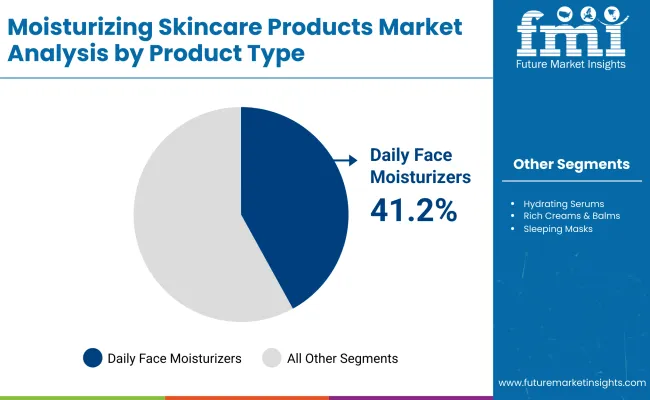
Product Type
Value Share % 2025
Daily face moisturizers
41.2%
Others
58.8%
The hydrating serums segment is projected to contribute 58.8% of the Moisturizing Skincare Products Market revenue in 2025, maintaining its lead as the dominant product category. Growth is driven by the widespread consumer shift toward lightweight, fast-absorbing, and high-hydration formulas that cater to multiple skin types.
Serums containing multi-molecular hyaluronic acid and niacinamide are preferred for their visible results and compatibility with layered skincare routines. The segment’s growth is also supported by innovation in texture technology and enhanced ingredient stability. With rising dermatological validation and expanding online sales channels, hydrating serums are expected to remain at the core of the moisturizing skincare portfolio.
Insights into the Key Ingredients Segment with Hyaluronic Acid Dominating the Demand
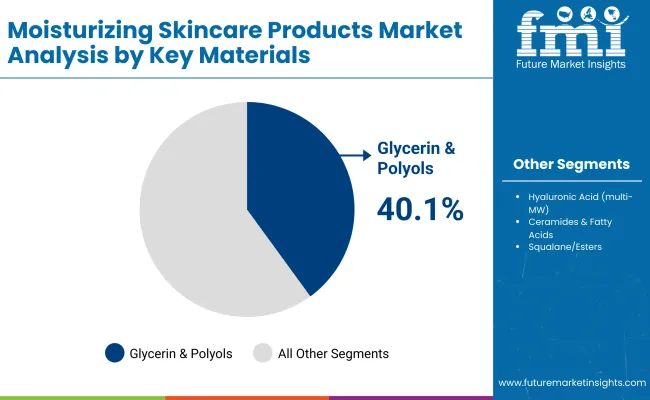
Key Materials
Value Share % 2025
Glycerin & polyols
40.1%
Others
59.9%
The hyaluronic acid (multi-MW) segment is forecasted to hold 58.8% of the market share in 2025, led by its extensive use in high-performance moisturizers and serums. Its superior water-retention ability, skin-plumping effect, and proven biocompatibility have made it a preferred ingredient for daily hydration and anti-aging care.
Multi-weight formulations combining low and high molecular weights enhance penetration and lasting moisture, appealing to both mass and premium consumers. As demand for clinically backed ingredients increases, hyaluronic acid remains the gold standard in advanced moisturizing formulations, fueling consistent market expansion through 2035.
Insights into the Skin Type Segment with Normal and Combination Skin Products Leading
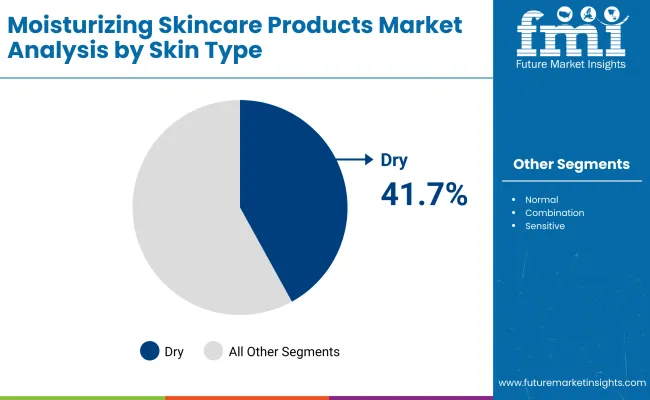
Skin Type
Value Share % 2025
Dry
41.7%
Others
58.3%
Products targeting normal and combination skin are projected to account for 59.9% of the Moisturizing Skincare Products Market revenue in 2025, establishing them as the leading skin-type category. This dominance reflects consumer demand for versatile, all-season moisturizers that balance hydration without heaviness. Gel-cream hybrids, oil-free emulsions, and adaptive barrier formulations are widely used in this category, offering comfort and breathability.
Advancements in skin microbiome research and personalized skincare diagnostics are further propelling demand. As climate-adaptive and multi-functional moisturizers gain traction, products catering to normal and combination skin are expected to sustain leadership across global markets.
What are the Drivers, Restraints, and Key Trends of the Moisturizing Skincare Products Market?
Rising Focus on Skin Barrier Health and Hydration Science
Growing consumer awareness of the skin barrier’s role in overall dermatological health is propelling the demand for moisturizing skincare products. Modern consumers seek formulations enriched with humectants, ceramides, and fatty acids that restore hydration while reinforcing the lipid barrier.
The clinical endorsement of barrier-repair products by dermatologists and increased inclusion of active ingredients like multi-molecular hyaluronic acid are amplifying adoption. This shift from cosmetic to functional skincare is also driving premiumization, as consumers increasingly associate hydration with anti-aging and long-term skin health benefits.
Expansion of E-Commerce and Personalized Skincare Platforms
The rapid rise of digital retail channels, AI-driven skin analysis tools, and influencer marketing has transformed how moisturizing skincare products are discovered and purchased. E-commerce platforms now enable hyper-personalized recommendations based on skin type, age, and climate conditions.
Subscription-based delivery models and refill systems further enhance customer retention and sustainability appeal. Leading brands leverage data analytics to tailor product suggestions, while digital dermatology consultations accelerate adoption. This seamless integration of technology and skincare retail is driving strong revenue growth, particularly across Asia-Pacific and North American online marketplaces.
Ingredient Sensitivity and Product Compatibility Concerns
While demand for moisturizers continues to expand, ingredient-related sensitivities and allergic reactions present a key restraint to market growth. Formulations containing synthetic emollients, fragrances, or alcohol-based compounds can trigger irritation among sensitive users. This challenge is heightened by the lack of standardized labeling for hypoallergenic claims across regions.
As consumers increasingly seek dermatologically tested and fragrance-free alternatives, brands must balance efficacy with tolerance. Regulatory scrutiny over ingredient safety and rising expectations for clean formulations may limit certain product innovations, impacting speed-to-market for new moisturizing solutions.
Hybrid Moisturizers with Functional and Aesthetic Benefits
A defining trend shaping the market is the emergence of hybrid moisturizers that combine hydration with targeted skin benefits such as brightening, firming, or sun protection. Consumers prefer multi-functional products that simplify skincare routines while delivering visible results.
These formulations often integrate actives like niacinamide, peptides, and SPF agents, merging skincare and cosmetic performance. Additionally, sustainable packaging and refillable jars are gaining traction among eco-conscious consumers. The convergence of dermatological efficacy, sensorial texture, and environmental responsibility is setting a new standard for innovation in the moisturizing skincare segment.
Analysis of Moisturizing Skincare Products Market By Key Countries
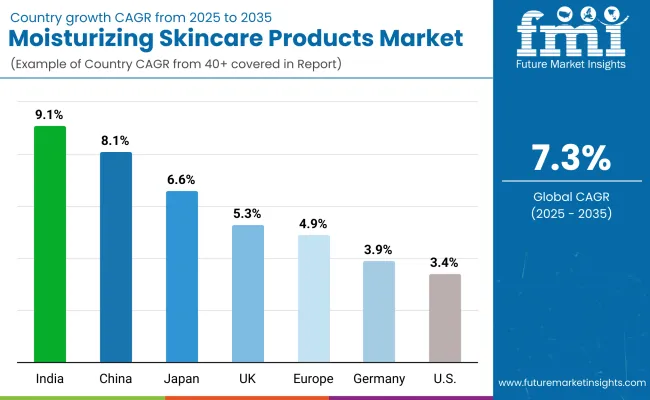
Country
Estimated CAGR (2025 to 2035)
China
8.1%
USA
3.4%
India
9.1%
UK
5.3%
Germany
3.9%
Japan
6.6%
Europe
4.9%
The global Moisturizing Skincare Products Market demonstrates significant regional variations in consumer adoption, driven by demographic structure, climate conditions, and evolving beauty standards. Asia-Pacific stands out as the fastest-growing region, anchored by India at 9.1% CAGR and China at 8.1% CAGR, supported by a youthful population, expanding middle-class income, and rapid urbanization.
India’s growth is propelled by mass-market affordability and the popularity of herbal and hybrid moisturizers, while China’s demand is led by premium hydration serums and clinical skincare brands. Japan (6.6%) maintains momentum through innovation in water-based emulsions and minimalist beauty routines emphasizing moisture balance.
Europe, led by the UK (5.3%) and Germany (3.9%), shows steady expansion supported by clean beauty formulations, regulatory compliance on ingredient safety, and high consumer trust in dermatological products. The USA market (3.4%) grows moderately, reflecting maturity and saturation in the premium segment, though innovation in hybrid moisturizers and online retail personalization continues to sustain value growth.
Sales Outlook for Moisturizing Skincare Products in the United States
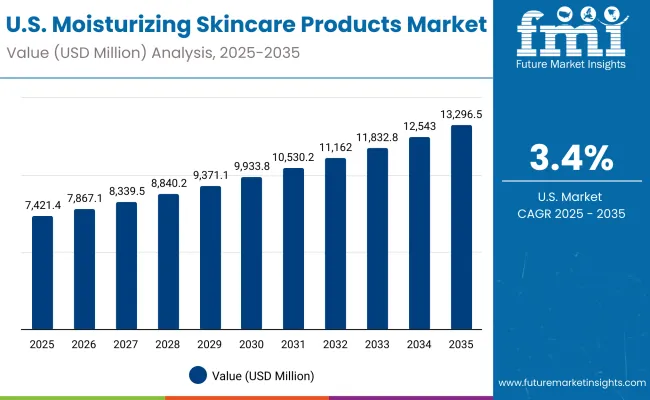
Year
USA Moisturizing Skincare Products Market (USD Million)
2025
7421.48
2026
7867.12
2027
8339.51
2028
8840.27
2029
9371.10
2030
9933.80
2031
10530.29
2032
11162.60
2033
11832.87
2034
12543.39
2035
13296.58
The Moisturizing Skincare Products Market in the United States is projected to grow at a CAGR of 3.4%, led by strong consumer preference for dermatologist-endorsed brands and premium hydration formulations. Growth is driven by expanding demand for barrier-repair creams, oil-free gels, and sensitive-skin moisturizers. E-commerce remains a dominant channel, supported by influencer marketing and personalized skincare recommendations. Premium and clinical brands like CeraVe, Cetaphil, and Neutrogena continue to lead, while AI-based skin analysis tools are reshaping product discovery and retention strategies.
Premium clinical skincare brands continue to dominate pharmacy and online channels.
Consumers favor lightweight, oil-free moisturizers suited for humid and urban climates.
E-commerce personalization and subscription models are driving repeat purchases.
Growth and Expansion Outlook for Moisturizing Skincare Products Market in the United Kingdom
The Moisturizing Skincare Products Market in the United Kingdom is expected to grow at a CAGR of 5.3%, supported by increasing adoption of clean-beauty formulations and fragrance-free moisturizers. The market benefits from growing awareness of hydration-led anti-aging care and dermatologist-recommended brands. Retailers are expanding eco-conscious offerings with recyclable packaging and refillable skincare jars. Online beauty platforms and pharmacy chains are integrating digital skin diagnostic tools to improve product matching. The regulatory emphasis on ingredient safety and transparent labeling continues to reinforce consumer confidence.
Clean and vegan moisturizers are seeing accelerated demand in premium retail.
Refillable and sustainable packaging formats are gaining strong acceptance.
Dermatology-led brands are expanding through pharmacy and e-commerce distribution.
Growth and Expansion Outlook for Moisturizing Skincare Products Market in India
India is witnessing rapid growth in the Moisturizing Skincare Products Market, which is forecast to expand at a CAGR of 9.1% through 2035. Rising disposable income, climate-adaptive formulations, and social media-driven beauty trends are key growth drivers. Domestic brands are capitalizing on herbal, ayurvedic, and hybrid moisturizer formulations, catering to local climatic needs. Increasing penetration in tier-2 and tier-3 cities through e-commerce and direct-to-consumer channels has broadened market access. Multinational brands are also localizing formulations for tropical humidity and diverse skin tones.
Local brands are blending herbal and clinical actives for cost-effective hydration.
E-commerce expansion is accelerating penetration in smaller Indian cities.
Climate-adaptive moisturizers are gaining traction among young consumers.
Sales Outlook for Moisturizing Skincare Products in China
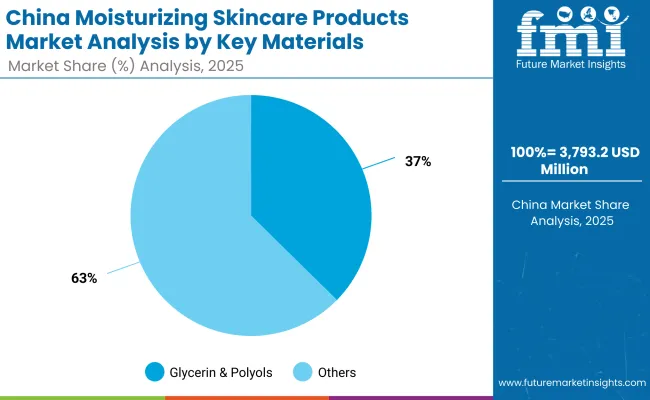
The Moisturizing Skincare Products Market in China is expected to grow at a CAGR of 8.1%, the highest among major global economies. Growth is driven by surging demand for high-performance hydrating serums and K-beauty-inspired formulations. Domestic innovation, premium imports, and influencer-led marketing have made moisturizers a daily essential across demographics. Government initiatives promoting domestic cosmetic R&D and clean formulation standards further support industry growth. Expanding e-commerce ecosystems like Tmall and Douyin are central to product visibility and recurring sales.
Serum-infused moisturizers are driving the premiumization of China’s skincare segment.
Local brands are innovating with hyaluronic and peptide-based hydration complexes.
Social commerce and live-streaming are accelerating consumer engagement and conversion.
In-depth Analysis of Moisturizing Skincare Products in Germany
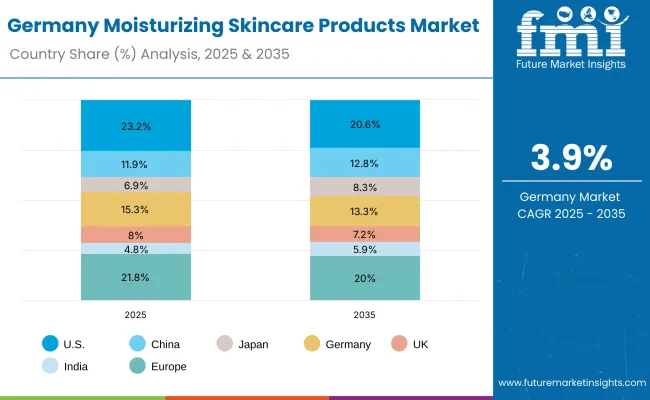
Country
2025 Share (%)
USA
23.2%
China
11.9%
Japan
6.9%
Germany
15.3%
UK
8.0%
India
4.8%
Europe
21.8%
Country
2035 Share (%)
USA
20.6%
China
12.8%
Japan
8.3%
Germany
13.3%
UK
7.2%
India
5.9%
Europe
20.0%
The Moisturizing Skincare Products Market in Germany is projected to grow at a CAGR of 3.9%, supported by high consumer preference for dermatologically tested, fragrance-free, and sensitive-skin-friendly formulations. German consumers emphasize product safety, clinical efficacy, and ingredient transparency, driving growth for pharmacy-based brands such as Eucerin, Nivea, and La Roche-Posay.
Moisturizers enriched with ceramides, fatty acids, and glycerin are favored due to their proven barrier-repair benefits. Regulatory rigor under EU cosmetic standards promotes clean-label formulations and eco-friendly packaging. The country’s mature yet innovation-driven beauty retail ecosystem continues to support premium skincare expansion.
Clinical and pharmacy brands dominate sales due to dermatologist endorsement.
Clean, fragrance-free, and pH-balanced moisturizers see strong adoption among sensitive-skin consumers.
Sustainability initiatives and EU green-packaging standards are influencing product design and formulation strategies.
Growth Outlook for Moisturizing Skincare Products Market in USA
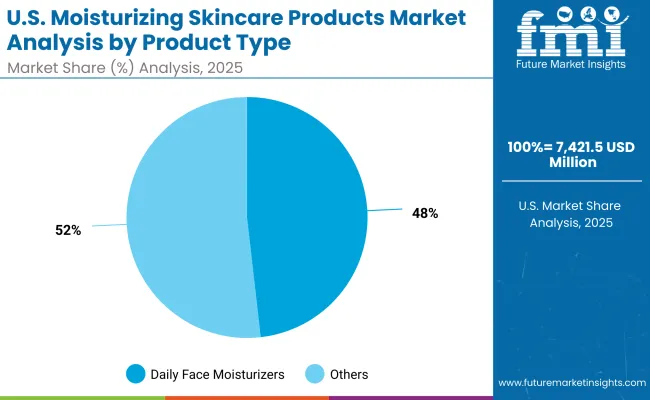
USA By Product Type
Value Share % 2025
Daily face moisturizers
48.2%
Others
51.8%
The Moisturizing Skincare Products Market in the United States is projected at USD 7,421.5 million in 2025. Daily face moisturizers contribute 48.2%, while other product types collectively hold 51.8%, reflecting a balanced consumer preference across lightweight and intensive hydration formats. This slight edge toward diversified formulations arises from the rising demand for multitasking serums, barrier-repair creams, and hybrid moisturizer-serum blends.
Premium pharmacy brands and dermatologist-backed labels continue to dominate, emphasizing clinical efficacy and sensitive-skin compatibility. Growth is reinforced by personalization tools, AI-powered product recommendations, and clean-label transparency shaping modern skincare decisions.
The USA market holds a 23.2% share of global revenue in 2025.
Serums and hybrid moisturizers slightly outperform traditional creams at 51.8% vs 48.2%.
Growth is driven by AI personalization, clean beauty, and dermatologist-recommended brands.
Opportunity Analysis of China Moisturizing Skincare Products Market

China By Key Materials
Value Share % 2025
Glycerin & polyols
37.4%
Others
62.6%
The Moisturizing Skincare Products Market in China is valued at USD 3,793.2 million in 2025, with formulations based on hyaluronic acid and other advanced actives holding 62.6%, followed by glycerin and polyols at 37.4%. The dominance of hyaluronic formulations reflects China’s growing appetite for high-efficacy hydration products emphasizing deep moisture retention and skin elasticity.
This preference is amplified by the popularity of K-beauty-inspired layering routines and the influence of clinical skincare brands. Rapid innovation by local manufacturers, integration of AI-based skin testing, and extensive use of e-commerce platforms such as Tmall and Douyin are creating scalable market opportunities.
Market size for China in 2025 is USD 3,793.2 million.
Global market share is approximately 11.9% in 2025, rising to 12.8% by 2035.
Hyaluronic-based moisturizers lead with 62.6% share, driven by demand for advanced hydration science.
Competitive Landscape of Moisturizing Skincare Products Market
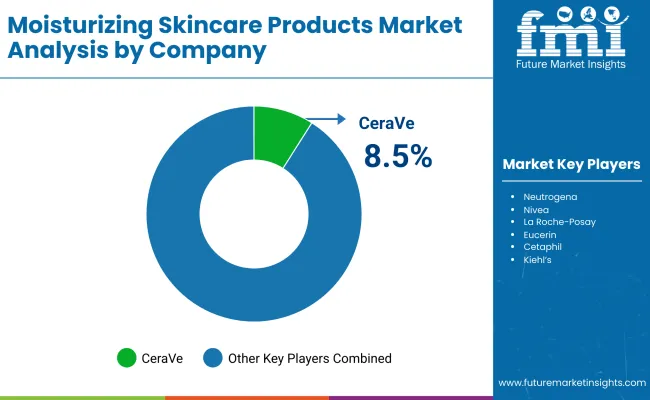
Company
Global Value Share 2025
CeraVe
8.5%
Others
91.5%
The Moisturizing Skincare Products Market is moderately fragmented, featuring a mix of global leaders, dermatology-backed brands, and niche premium innovators competing across diverse consumer segments. Global market leaders such as CeraVe, Neutrogena, and Nivea hold significant share, supported by dermatologist endorsements, clinical validation, and barrier-repair formulations rich in ceramides and hyaluronic acid. Their strategies emphasize science-backed claims, clean-label transparency, and digital retail expansion through pharmacy and e-commerce channels.
Mid-tier brands including Eucerin, La Roche-Posay, and Cetaphil focus on sensitive-skin and therapeutic moisturizers, expanding reach through dermatologist networks and sustainability-certified packaging. Emerging premium players such as Kiehl’s, Olay, and The Ordinary are redefining value perception through personalized routines, active-rich compositions, and hybrid serum-moisturizer launches.
Competitive differentiation is shifting toward AI-powered skin analysis, AR-based virtual try-ons, and data-driven product customization, marking a transition from traditional brand loyalty to performance-based consumer engagement. Subscription skincare programs, digital consultations, and cross-platform retail strategies are expected to define long-term growth dynamics.
Key Developments in Moisturizing Skincare Products Market
2025, L’Oréal’s CeraVe launched an AI-powered “Barrier Health Scan” in partnership with Google Cloud, enabling consumers to assess hydration levels and receive personalized moisturizer recommendations in real time.
2025, Beiersdorf (Nivea) introduced a refillable jar system across Europe, designed with fully recyclable components and a 70% reduction in plastic use per refill cycle, reinforcing its sustainability-driven growth strategy.
Scope of the Report
Item
Value
Quantitative Units
USD 32,004.7 Million
Product Type
Daily face moisturizers, Hydrating serums, Rich creams & balms, Sleeping masks
Key Ingredients
Glycerin & polyols, Hyaluronic acid (multi-MW), Ceramides & fatty acids, Squalane/esters
Skin Type
Dry, Normal, Combination, Sensitive
Channel
Pharmacies/drugstores, E-commerce, Supermarkets & hypermarkets, Specialty beauty retail
End User
Women, Men, Unisex family care, Senior skin
Regions Covered
North America, Europe, Asia-Pacific, Latin America, Middle East & Africa
Country Covered
United States, Canada, Germany, France, United Kingdom, China, Japan, India, Brazil, South Africa
Key Companies Profiled
CeraVe, Neutrogena, Nivea, La Roche-Posay, Eucerin, Cetaphil, Kiehl’s, Olay, The Ordinary, Clinique
Additional Attributes
Dollar sales by product type and key ingredient segment, adoption trends across dermatology clinics, retail pharmacies, and e-commerce platforms, rising demand for hydration-focused formulations with clinically validated actives, sector-specific growth in women’s skincare, men’s grooming, and senior skin hydration, revenue segmentation by premium and mass-market price tiers, integration of AI-based skin diagnostics, AR-enabled virtual skin analysis, and personalized product recommendation platforms, regional growth trends influenced by digital beauty ecosystems and sustainability-driven packaging innovations, and advancements in multi-molecular hyaluronic acid, ceramide complexes, and squalane-based moisturizing technologies.
Key Segments By Product Type:
Daily face moisturizers
Hydrating serums
Rich creams & balms
Sleeping masks
By Key Ingredients:
Glycerin & polyols
Hyaluronic acid (multi-MW)
Ceramides & fatty acids
Squalane/esters
By Skin Type:
Dry
Normal
Combination
Sensitive
By Channel:
E-commerce
Pharmacies/drugstores
Specialty beauty retail
Supermarkets & hypermarkets
By End User:
Women
Men
Unisex family care
Senior skin
By Region:
North America
Latin America
Europe
East Asia
South Asia & Pacific
Middle East and Africa
Frequently Asked Questions
How big is the Moisturizing Skincare Products Market in 2025?
The global Moisturizing Skincare Products Market is estimated to be valued at USD 32,004.7 million in 2025.
What will be the size of Moisturizing Skincare Products Market in 2035?
The market size for the Moisturizing Skincare Products Market is projected to reach USD 64,508.3 million by 2035.
How much will be the Moisturizing Skincare Products Market growth between 2025 and 2035?
The Moisturizing Skincare Products Market is expected to grow at a 7.3% CAGR between 2025 and 2035.
What are the key product types in the Moisturizing Skincare Products Market?
The key product types in the Moisturizing Skincare Products Market are daily face moisturizers, hydrating serums, rich creams & balms, and sleeping masks.
Which range segment to contribute significant share in the Moisturizing Skincare Products Market in 2025?
In terms of product range, Daily face moisturizers are expected to command a 41.2% share in the Moisturizing Skincare Products Market in 2025.

